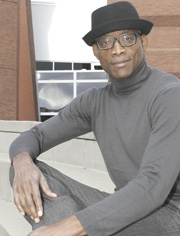
Just Our Bill
Acclaimed choreographer Bill T. Jones returns to Houston with his provocative work ‘Chapel/Chapter.’
By Neil Ellis Orts
Photo by Kevin Fitzsimmons, Wexner Center for the Arts

Of course, there is much more to know about the man and his work.
Jones’ latest work is on view this month in Chapel/Chapter, the evening-length show currently on national tour and coming to Jones Hall on March 28 (presented by Society for the Performing Arts). The work presents three narratives juxtaposed against each other and woven around each other. They are tales of startling violence and complicated emotions, which portray the way relationships play out within these circumstances. This is, of course, only a surface reading of the piece.
In YouTube previews of Chapel/Chapter, the viewer can hear religious-like chants, strident guitar noise, and spoken text. Dancers dress in prison-orange coveralls and solid black. There is reverence and anger. The set moves between darkness, shadow, and light.
Chapel/Chapter had its beginnings when Jones’ partner’s French mother visited for a month before Memorial Day. The then-recent Zacarias Moussaoui trials had ended with the judge predicting that the newly convicted terrorist would be forgotten. In a conversation, the Frenchwoman mentioned the oubliette, a feature in medieval castles, a hole in the floor through which noblemen might drop people they wished to be forgotten. All this judgment and forgetting so near a day called “memorial” set Jones’ creative process in motion.
Jones says he had the title before he began work—“Titles help organize my feelings,” he says—and he knew he wanted to explore something about modern sacred space. He also knew that this was impossible without addressing evil and how we engage it. “I knew [this piece] would try to create the sense of being in a place of judgment,” he says. This “religious space/legal space” dichotomy drives the dramatic tension of Chapel/Chapter.
Past work from Jones shows that he has never shied away from difficult topics. One of his more famous pieces, Still/Here, directly addresses his HIV-positive status by exploring a spectrum of people with life-threatening or terminal illness. Titles like Last Supper at Uncle Tom’s Cabin/The Promised Land tell you he will confront race issues with his multicultural company. Another Evening: I Bow Down explores disaster, full of water images from Noah, the Titanic, and New Orleans. Even with these works, Jones says he isn’t an activist (“An activist is out doing very different things from what I’m doing”) but an artist exploring the “mysterious nature of experience” from a more philosophical or spiritual perspective.
The New York Times review of Chapter/Chapel opened with this observation: “All this time, people have been complaining about Bill T. Jones, or praising him, for being political. It turns out he was instead being moral, even religious.” When I ask Jones how he responds to this statement, he simply replies, “I’m sorry it took so long for them to figure it out.”
If you’ve read anything about the Bill T. Jones/Arnie Zane Dance Company, you know that the company was founded by Jones and the late Arnie Zane. The two men met in college and became partners in art, life, and love. As Out noted in its recent Out 100 issue, Jones and Zane, an African American and a Jew, marched in demonstrations while still in college, dressed in drag and holding hands. Zane and Jones were simultaneously diagnosed as HIV-positive in 1984. Zane died in 1988. Jones remains healthy and symptom-free. Where closets are concerned, Jones was never “in.”
A strength of Jones’ work is his willingness to explore his experience as a black, HIV-positive gay man through the experiences of non-black, straight, HIV-negative men and women. He doesn’t explore only HIV but also cancer. His multracial company doesn’t address only the “black experience,” but considers a fuller spectrum of dynamics among people of every ethnicity. “I truly believe in engagement, participation in the world,” Jones says. If his personal experience starts a creative journey, he is also clear that he must explore beyond his experience. To paraphrase an old writing adage, Jones doesn’t dance only what he knows, but also what he finds out.
At the same time, he has written in his blog that part of what drew him to modern dance is the fact that it was a medium where gay men were prominent and gender roles were already being questioned and explored. Who lifts whom? Who partners whom? He expressed to me his desire that the gay community know and pay attention to modern dance. “It is a distinctively American art form,” he says, “one that gay men have helped shape from the beginning.”
If you’ve only read program notes or a brief news piece about Bill T. Jones, there is one thing you may not have noticed about him. The word community is very important to him.
“Bill T. Jones is something of the brand name,” he says, “but my company isn’t just me but a community of people working together. Some have been with the company for a very long time.”
Indeed, there are several company members and collaborators who have more than a decade of history—up to two decades in some cases—with the Bill T. Jones/Arnie Zane Dance Company. These individuals include the associate artistic director and video designer Janet Wong, the creative director and set designer Bjorn G. Amelan, and actor/choreographer Andrea Smith. Jones speaks of these longtime collaborators with gratitude, affection, and a profound appreciation that this company is not a one-man show.
As our too-brief conversation comes to an end, Jones speaks of his values, often with the qualifiers of a man who understands the slipperiness of language. “I remain hopeful,” he says. “I still like people. I believe love is important, even if I don’t know exactly what love is. I try to bring some standard of beauty to my work.” He pauses briefly. “And we can talk all day about what beauty is.”










